
Needle and Suture Pages: 1 2 3 4 5 Next>>
Needles and Suturing in the Golden Age of Piracy, Page 1
"Suture is a Chirurgical Operation, which, by means of a Threaded-Needle, contributes to the re-uniting and restoring to a perfect Continuity the parts of our Bodies violently divided, and that whilst yet a Bleeding." (Pierre Dionis, A course of chirurgical operations: demonstrated in the royal garden at Paris. 2nd ed., p. 37)
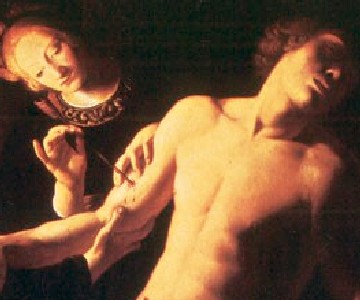
Artist: Trophime Bigot - St. Sebastian Healed by Irene (17th Century)
Many people think of suturing when they hear the word 'surgeon'. Surgery entails a great many other tasks, but suturing is one of those operations that seems to have been indelibly linked to the job in our minds.
Suturing was a facet of surgery during the golden age of piracy, although perhaps not one as widely employed then as it is today. Randolph Fillmore says that "closing wounds with sutures was not a standard practice in the eighteenth century."1
There are a variety of reasons suturing was not as widely used. The first has to do with humor theory. During the late 17th and early 18th centuries, wounds were thought to be the place where bad humors (types of bodily fluids) gathered and were generated. It was widely believed that for a wound of the body to heal, the surgeon first had to allow the bad humors passage out of the body. Many wounds were intentionally left open for this reason.
Although he doesn't directly reference humors, Fillmore implies it noting that "Many surgeons preferred to let a wound, even an amputation, heal without drawing the edges of flesh together. Leaving the wound open to provide drainage... Packing the wound with a porous lint-like material also allowed drainage.”2
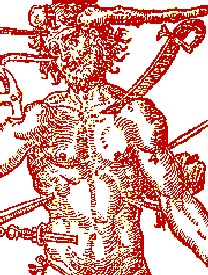
A 'Wound Man' with Multiple Chest and
Abdominal Wounds, From De Chirurgica
Institutione Libri Quinque, by Jean
Tagaut, p. 151 (1547)
A second reason sutures were not quite as prevalent then is that a lot of the modern surgical procedures that require suturing concern the organs in the chest and abdomen. With a few exceptions, these were parts of the body that were avoided by period surgeons unless it was absolutely necessary. The science of medicine was not well developed and the mortality rate of operations on these parts of the body was high. Sea surgeon John Woodall advised that "if the liver, splene, stomack, kidnies, or bladder be wounded, let nature work its part, for there is small hope by art [surgery] to prevail."3 Fellow sea surgeon John Moyle agreed, noting that "All Wounds penetrating in the Breast, Back, or Belly are dangerous, especially when any of the Vissora are wounded: But if the inward great Vessels are wounded, then 'tis usually mortal."4
A final reason suturing was not as widely employed at this time is that procedures and tools were not as refined as they are today. For example, we know it is possible to successfully sew a dismembered body part back into place, but this was not considered possible to surgeons operating during the golden age of piracy. Still, when a part was not wholly separated, the surgeons would attempt to reattach it. Ambroise Paré noted that while a completely severed ear couldn't be reattached, if it is "only slit, so that the rent portion as yet adhering to the rest, [it] is [still] joyned with it [the rest of the body] in communion of life".5 Thus it could be sewn back together.
With this in mind, this article will examine suturing during the golden age of piracy. We will begin with a look at the tools involved in the process including the needle, cannulas (needle guides/holders) and the suture material. Next we will examine adhesive sutures in use at this time. Then we will move on to the more traditional sutures focusing on when and how they were used, not used and eventually removed when the job was finished. We will finish with a brief review of several operations that made of use suturing from the period.
1,2 Randolph Fillmore, “Surgery in the 1700s”, Science and Its Times, Volume 4, Gale Group, 2000, p. 140; 3 John Woodall, the surgions mate, 1655 edition, p. 94; 4 John Moyle, The Sea Chirurgeon, 1702 ed., p. 116; 5 Ambroise Paré, The Workes of that Famous Chirurgion Ambrose Parey, p. 295
Suture Instruments
"The Surgions Mate [assistant] ought also daily to visite the Cabines of men, to see who hath any sicknesse or Imperfection: also to have ready against occasion ...Needles prepared, for stitching wounds... and each other needful thing for his calling readie in their convenient places, placed against occasion be." (John Woodall, the surgions mate, p. 2)
The tools are required for suturing are fairly simple and straightforward. The most basic elements are the needle, scissors and suturing material (or thread, although that term is something of an oversimplification.) Surgeons often use a mechanical device to better to hold and direct the needle and suture. During the golden age of piracy, a device called a cannula or quill was widely used to hold and direct suture needles. Let's look at these in detail.
Suture Instruments: Needles
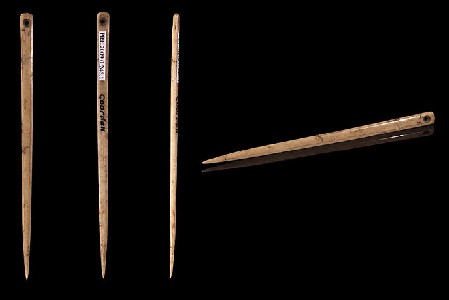
Photo: Didier Descouens
Bone Needles, From Gourdan cave,, France, Museum of Toulouse, (17,000 - 10,000 BC)
Needles are key to an effective suture. Eyed needles date back to 50,000 - 30,000 BC, with bone needles designed around 20,000 BC "were of a standard unsurpassed until the Renaissance."1
Although we don't have direct evidence of skin suturing from this time, David Mackenzie points out the we do have evidence of pre-historic man surviving trepanning - the operation of making holes in the skull to relieve pressure - which likely was accompanied with some method of closing the skin to allow it to repair itself.2
Around the 6th century BC, the Indian Ayuvedic Sanskrit text Sushruta Samhita listed a variety of medical tools necessary for surgery which included "triangular, round-bodied, curved and straight needles."3
Still, bone needles may not have been the best medium for medicine. Naval medicine historian John Kirkup advises "Eyed ivory and bone needles…are unlikely candidates for wound closure, as significant bulk around the eye combined with a doubled-over thread would have precluded easy penetration of the skin; the resistance encountered would have been considerable and probably would have broken the eye."4
Closer to the golden age of piracy there are a variety of references to metal suturing needles. In treating a wound in the late 16th century, the English military surgeon William Clowes wrote, "I did prepare a sharp and square pointed needle" in preparing to close the wound.5

Paré's Triangular Needle, From The Workes of that Famous Chirurgion Ambrose
Pare,
p. 293 (1649)
Writing about a century later, the famed French surgeon Ambroise Paré explained how for sutures, the surgeon "must have a smooth needle with a threed in it, having a three square point, that so it may the better enter the skin, with the head of it some what hollowed, that the threed may lie therein; for so the needle will the better goe through."6 It is interesting that the

A Straight and Curved Suture Needle, From The Workes of that Famous
Chirurgion Ambrose Pare, p. 256 (1649)
needles Paré taper out from the point, probably so that they would make the hole large enough that the head and eye would pass easily through.
In the early and mid 17th century, John Woodall advised the inclusion of needles among the tools that sea surgeons would carry in his book the surgions mate. He tells his readers that they should have "stitching needles" in their plaster boxes.7 Plaster boxes were the period equivalent of modern first aid kits that the surgeon's mates (or assistants) would carry with them to attend to the sailors daily - they get their name from the fact that they contained bandages prepared with medicinal plasters.
Woodall expands upon this, telling his charges "that they may be the more ready on the suddaine as occasion is offered, forget not to have at the least three ready needles well armed and pointed of several sizes"8. This leads to the question of how many needles a sea surgeon might have had. Woodall is the only period or near-period sea surgeon to provide images of his tools in his book, but he unfortunately doesn't include needles among them.
Sea surgeon John Moyle doesn't provide images or a list of tools, simply indicating that the surgeon would need "A set of large Instruments, and a Box of small, aliaq; necessaria [others as necessary]."9 Sea surgeon John Atkins gives even less instruction, simply referring to the newly coined sea surgeon as needing instruments.10 So we receive no assistance in learning about the quantity of needles a sea surgeon might have from these sources.
Presumably a sea surgeon would want more needles than a land-based one due to his inability to easily procure more of them. 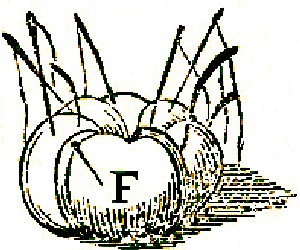
Needles in Cushion, From Pierre Dionis' Cours d'Operation,
Fig VIII, p. 59 (1740)
When discussing how needles were purchased during the time, John Kirkup notes that surgeons would request "a sailmaker’s curved needle, or any appropriate needles made for another craft"11.
In his lectures, French surgical instructor Pierre Dionis advises "the Chirurgeon ought to be provided with Cushions, F, stuck with Needles... of all sorts, straight, curve, large, small, round, flat, and triangular, threaded with several sorts of Thread, to the end that he may have ready before his Eyes what is proper for the Wound to be sewed up; otherwise he will frequently be oblig’d either to make use of an improper Needle, or to wait the coming of one sent for."12 Dionis' diagram contains nine needles, four curved and five straight in a rather quaint pin-cushion. These only represent those Dionis suggested the surgeon have ready for use; there might well have been more needles not armed with thread, particularly for a surgeon at sea.
Another question arose as to the type of needle that would be used for suturing. Kirkup suggests that "suture needles were principally employed for skin closure, and their variety and range was small."13 However, Dionis' above quote suggests some reasonable variety of needle types and sizes existed.
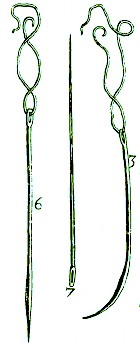
Needles, From Jacques
Guillemeau's The French
Chirurgerie
(1597)
Both straight and curved needles were part of the golden age of piracy's surgeon's kits. Surgical instrument historian Elizabeth Bennion notes that while straight needles were primarily used for suturing, "from the late eighteenth century one can find curved specialist needles in most large cases of instruments."14 Since Paré's late 16th century book features them, we know they go back far before the golden age of piracy.
Writing in 1597, Jacques Guillemeau shows three needles in his discussion of suturing and suturing materials, one of which is curved. He explains the curved needles: "3, The recurvede Needle for the sutures of the face, & other partes, where the righte needle can not be usede."15 While not entirely clear what a 'righte' needle is, it suggests a straight needle. Of his two straight needles, Guillemeau gives the following details:
6, The Needle for woundes, which at her acuitye, or poyncte [point] is triangulate and rescindate [having a cutting edge] because by that meanes shee might the easyer entre: for in thrustinge shee inscideth [incides - cuts] with her edges.
7, The Needle to sowe together all cloutes [pieces of cloth], and roulers [roller bandages] to dresse [patients] withall.16
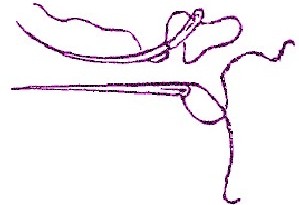
Needles, From Pierre Dionis' Cours d'Operation,
Fig II, p. 11 (1740)
Pierre Dionis explains that the straight needle "is very much used by Chirurgeons, and that on so many different Occasions, that they are obliged to be provided with all its several Sorts"17. He also explains that a curved needle must be made "course and strong, for it frequently bends or breaks"18, suggesting there that straight needles are preferable.
Yet Dionis also says that the curved (or 'crooked' needle) can be used in "the same [way as] with the straight one; besides which 'tis absolutely necessary in the Gastrorhaphia, or Suture of Wounds of the Belly."19 He elsewhere advises,
[W]e ordinarily choose a Needle proportionable to the Nature of the Wound, in order to which we must be provided with those of several Shapes and Sizes: There are straight ones, and others more or less Curve; but the crooked ones are preferable, because there are no places of the Body to which they cannot be used, and that more conveniently than those which are straight20
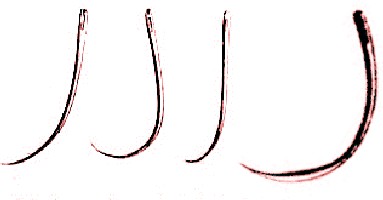
A Variety of Curved Suture Needles, From A General System of Surgery,
by Lorenz Heister,
Plate 1 (1770, initially published 1739)
In this comment, Dionis appears to favor the curved needle in surgery despite its brittleness.
Needles during this time were usually made of steel, or possibly iron. (Steel would have been preferred, but would also have been more expensive.) Both of these materials are less durable from a modern standpoint. In gathering information for his book on the history of surgical instruments, John Kirkup noted that a problem with trying to find examples of needles from this era is that they "gradually corrode, especially when made of iron or steel, and few from before the eighteenth century have survived intact."21
Dionis comments on the material qualities of an effective suturing needles, telling his students that "their Steel must not be brittle, but yet a little hard, that it may not bend; they ought to be polished, sharp-pointed, and wholly free from Rust, that they may the quicker make their way [through the skin], and that in their passage through a Wound they don’t rase [raze – scrape] it."22
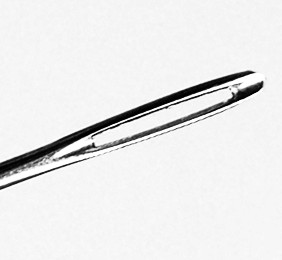
Photo: Pavel Krok
Needle Eye - Note the 'Gutter' for the Thread
The most challenging part of a needle - both for the makers and the surgeon - was the needle's eye. As Kirkup explains, "Eyed needles are difficult to fashion from organic materials in sufficiently narrow caliber to penetrate human skin easily. To avoid breakage of the eye during manufacture, an excessively thickened needle head is required, for even metallic needles are weakest at the eye where they are prone to fracture."23
Of course a thicker head meant more material must be passed through the aperture made in the skin when drawing a needle through. With this in mind, Pierre Dionis advised his students that when choosing a needle "its sides should be excavated like a small Gutter, that the Thread placing its self in those little Notches, may not stop the Needle by hindring its easy passage, by reason of the clumsy thickness it may give the Head."24
1,2,3 David Mackenzie, "The History of Sutures", Medical History, April 1973, p. 158; 4 John Kirkup, The Evolution of Surgical Instruments; An Illustrated History from Ancient Time to the Twentieth Century, p. 179; 5 William Clowes, Selected Writings of William Clowes, p. 107; 6 Ambroise Paré, The Apologie and Treatise of Ambroise Paré, p.127;7 John Woodall, the surgions mate, p. 24; 8 Woodall,p. 26; 9 John Moyle, The Sea Chirurgeon, 1702 ed.,. p. 33; 10 John Atkins, The Navy Surgeon, Introduction; 11 Kirkup, p. 176; 12 Pierre Dionis, A course of chirurgical operations: demonstrated in the royal garden at Paris. 2nd ed., p. 42;13 Kirkup, p. 176; 14 Elizabeth Bennion, Antique Medical Instruments, p. 74; 15,16 Jacques Guillemeau, The French Chirurgerie, (13th unnumbered page in the beginning); 17,18, 19, Dionis, p. 16; 20, Dionis, p. 39; 21 Kirkup, p. 179; 22 Dionis, p. 39-40; 23 Kirkup, p. 339; 24 Dionis, p. 40
Suture Instruments: Needles - Punctus Aureus
There is one other type of needle discussed in Paré's book that is included here mainly for its rather curious features. This needle was used to to treat hernias, which occur when an organ is pushing through the peritoneum or lining of the abdominal cavity. Paré used this tool to stitch hernias which couldn't be cured by other methods "by reason of the great solution of the continuity [size of the large wound] of the relax'd or broken Peritonæum"1. He stitched the broken peritoneum with soft wire (such as gold or lead), carefully cutting the ends so they didn't irritate the
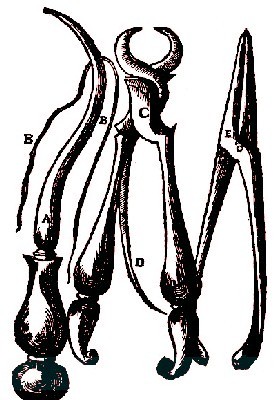
Punctus Aureus Tools, From The Workes of that
Famous
Chirurgion Ambrose Pare, p. 243 (1649)
A) The Needle, B) The Gold Wire, C) Cutting Pincers
D) The Spring on the Pincers, E) The Mullets
flesh and then sewed the skin covering the peritoneum up with normal threaded suture, leaving the wire inside. Her referred to this operation as the Punctus Aureus or golden ligature.
Punctus Aureus is a delicate operation, requiring "a Chirurgeon which hath a skillful and sure hand"2, suggesting it probably wouldn't be performed on a ship. In addition, it appears to have fallen out of favor, at least by the end of the golden age of piracy. In 1729, Physician Daniel Turner discussed this operation saying, "I will not trouble you with enlarging upon these Inventions, furnishing [them], I think, rather [as a] Matter of Amusement, than useful practice; though all of them seem to have been experimented in Former Times"3.
There are two interesting features of the needle used in Punctus Aureus. The first interesting feature is its handle, which allows easier manipulation and the use of more force when suturing. Because of this, It cannot go through the skin in the way we typically think of suture needles doing. Rather, the wire is poked through the peritoneum (which is a tough membrane) and then drawn out using what Paré called the 'mullets' (marked as E in the image.) The second interesting feature is the placement of the eye; it is not distal (located at the back of the needle), but is proximal (located near the middle).4 This is again a function of the way the needle worked. Since it not drawn through, the thread must be closer to the piercing tip of the needle, or, as Paré explains "having an eye not far from the point"5. That way the needle can be poked through the peritoneum being sutured, bringing the wire with it to be grabbed and pulled by the mullets.
1,2 Ambroise Paré, The Workes of that Famous Chirurgion Ambrose Parey, p. 242; 3 Daniel Turner, The Art of Surgery, p. 310-1; 4 John Kirkup, The Evolution of Surgical Instruments; An Illustrated History from Ancient Time to the Twentieth Century, p. 339; 5 Paré, p. 243
Suture Instruments: Needles - Manufacture
Surgical instrument historian John Kirkup notes that there were no needle makers during this time period producing needles specifically for surgery. As a result the surgeon was left to purchase needles designed for sewing cloth, sail and leather.1 As noted previously, needles in the golden age of piracy were made of iron and steel, with steel being preferred for surgical purposes because of its strength. Curiously, surgical needles do not appear to have been particularly fine according to Michael Morrall, who explains that in Buckinghamshire in the 17th century the needles produced there were "of a larger description, namely, sail and sacking needles, together with those used for netting and surgical purposes."2
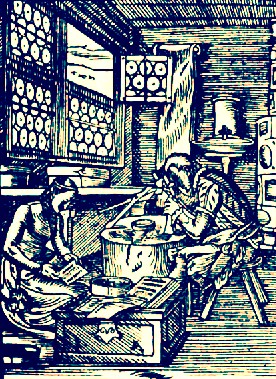
Needle Maker, From Das Standebuch by Jost Amman (1586)
Needle makers in England had their origins in the Studley Priory in Warwickshire.3 "When Henry [VIII] perpetrated the dissolution of the monasteries [in the mid 16th century] the needle-making monks merely girded their habits and moved to the nearest town, Redditch and there they stayed."4
Needles were made in various other locations around England during this period including Wales5. By the end of the 16th century, England was making sufficient numbers of needles to meet the needs of the country and even exporting them.6 King Charles II granted the needlemakers guild a royal charter in 1664.7
Michael Morrall gives a rather interesting account of how needles were made "FROM AN OLD VOLUME"8. Although it is a too long to reprint here in full, it is worth summarizing.
Wire is drawn to the required fineness and cut into pieces which are the length of the needle being made. The end is flattened so that the head and eye of the needle could be created on an anvil. Each piece is heated and "a square punch is hammered half through, which process is termed first eyeing."9 It is then placed on a lead block where another punch is used to finish the eye. Next, a groove is cut on each side of the eye (the gutter), which also removes burrs and roughness.
The needle is then heated red hot and hardened in a cold water bath. It is then reheated to temper the steel and reduce brittleness. The needle is re-straightened on an anvil where "a few gentle taps makes it perfectly straight."10 It is next put (along with 12,000 of its brothers) "on a piece of new buckram [still linen], sprinkled with emery dust [an abrasive powdered rock] and oil of olives, and make up in a roll well bound at each end."11 This roll was placed on the ground where workers scoured the needles by moving the roll back and forth with their feet, "by which means they become bright."12 Finally, the needles are washed and placed in a box filled with bran which is stirred until both the needles and bran are dry.
1 John Kirkup, The Evolution of Surgical Instruments; An Illustrated History from Ancient Time to the Twentieth Century, p. 176; 2 Michael Morrall, History and Description of Needle Making, p. 4; 3 Morrall, p. 3; 4,5 David Mackenzie, "The History of Sutures", Medical History, April 1973, p. 164; 6 Morrall, p. 4; 7 "Our History" www.needlemakers.org.uk, gathered 2/9/15; 8 Morrall, p. 10; 9,10,11,12 Morrall, p. 11

